IAI Heron
| Heron | |
|---|---|

| |
| Role | Unmanned aerial vehicle |
| National origin | Israel |
| Manufacturer | Israel Aerospace Industries |
| First flight | 1994 |
| Primary users | Israeli Defence Force Indian Air Force Brazilian Federal Police Turkish Air Force |
| Variants | EADS Harfang IAI Eitan Caçador |



The IAI Heron (Machatz-1) is a medium-altitude long-endurance unmanned aerial vehicle (UAV) developed by the Malat (UAV) division of Israel Aerospace Industries. It is capable of Medium Altitude Long Endurance (MALE) operations of up to 52 hours' duration at up to 10.5 km (35,000 ft). It has demonstrated 52 hours of continuous flight, but the effective operational maximal flight duration is less, according to payload and flight profile. There is a new version, Heron TP, also known as IAI Eitan.
On 11 September 2005, it was announced that the Israel Defense Forces purchased US$50 million worth of Heron systems.[1]
Design and development
Heron navigates using an internal GPS navigation device, and either a pre-programmed flight profile (in which case the system is fully autonomous from takeoff to landing), manual override from a ground control station, or a combination of both. It can autonomously return to base and land in case of lost communication with the ground station. The system has fully automatic launch and recovery (ALR) and all-weather capabilities.
Heron can carry an array of sensors, including thermographic camera (infrared) and visible-light airborne ground surveillance, intelligence systems (COMINT and ELINT) and various radar systems, totaling up to 250 kg (550 lb). Heron is also capable of target acquisition and artillery adjustment.
The payload sensors communicate with the ground control station in real time, using either direct line of sight data link, or via an airborne/satellite relay. Like the navigation system, the payload can also be used in either a fully pre-programmed autonomous mode, or manual real-time remote operation, or a combination of both.
Super Heron
At the Singapore Air Show in February 2014, IAI unveiled the Super Heron refinement of the Heron UAS. The Super Heron has a heavy fuel 200 horsepower engine that increases its rate of climb and performance. Its range is 250 km (160 mi) line-of-sight and 1,000 km (620 mi) by satellite control. Endurance is 45 hours at a maximum altitude of 30,000 ft (9,100 m). Cruising speed is 60 to 80 kn (110 to 150 km/h; 69 to 92 mph) and top speed over 150 kn (280 km/h; 170 mph).[2]
Operational history
The Heron saw significant use during Operation Cast Lead in Gaza of 2008–2009. During the deployment, each brigade combat team was assigned a UAV squadron for close support. This was the first Israeli operation in which UAVs, helicopters, and fighter jets were allocated to ground forces directly without IAF central command authorizing sorties. Air-support controller teams operated alongside brigade commanders at the front emphasizing the brigade commander's utilization of direct air assets.[3] A high degree of situational awareness was achieved by maintaining at least a dozen UAVs in flight over Gaza at all times. Aerial surveillance was provided by Heron and Hermes 450 UAVs and Apache attack helicopters. Along with coordination between the Air Force and ground troops, Israel ground forces were able to utilize cooperation with the Israel Security Agency by having operatives attached to the forward units. This inter-service coordination allowed for a higher level of tactical awareness and the ability to strike time-critical targets.[4]
Other countries operating the Heron include Singapore, India and Turkey.[5] France operates a derivative of Heron named Eagle or Harfang.[6] In 2008, Canada announced a plan to lease a Heron for use in Afghanistan, starting in 2009.[7] As of mid-2009, Australia leased two Herons as part of a multimillion-dollar lease to operate the vehicles in Afghanistan.[8] In early July 2013, the Heron reached 15,000 flight hours over Afghanistan.[9] Australia concluded its use of the Heron in support of Operation Slipper in Afghanistan on 30 November 2014, after it had accumulated 27,000 flight hours.[10]
Heron variants
- Turkey operates a special variant of the Heron, which utilizes Turkish-designed and manufactured electro-optical subsystems. For example, the Turkish Herons use the ASELFLIR-300T airborne thermal Imaging and targeting system designed and manufactured by ASELSAN of Turkey. The Turkish Herons also have stronger engines in order to compensate for the added payload created by the heavier ASELFLIR-300T. This is the same FLIR system currently used in the TAI/AgustaWestland T-129 attack helicopter[11] and also the TAI Anka MALE UAV. IAI staff maintain that the Turkish Heron's "with its enhanced performance, is better than all existing Heron UAVs operating worldwide”.[12] Turkish Aerospace Industries (TUSAŞ) provides maintenance and overhaul services for its Herons.[13]
- EADS Harfang - variant operated by France
Operators


- Azerbaijani Air Forces - five[14]
- Royal Canadian Air Force – formerly operated three;[18] two + still in operation, the rest ceased operation in 2011
- Ecuadorian Navy – two[19]
- German Air Force – three plus two ground stations on an initial one-year lease starting in 2010[20][21]
- Israeli Defence Force – one +[25]
- Royal Moroccan Air Force – three [26]
- Republic of Korea Army – three on order[29]
- Turkish Air Force – ten
- United States Navy – two[30]
Specifications
Data from "Heron/Shoval/Eitan". Israeli-weapons.com. Retrieved 18 November 2012.
General characteristics
- Crew: two on ground
Performance
- Endurance: 52 hours[31]
- Payload: 250 kg (550 lb)
See also
Related development
Aircraft of comparable role, configuration, and era
References
- ^ "Israel Aerospace Industries Ltd. - Home page". Iai.co.il. Retrieved 18 November 2012.
- ^ IAI Unveils Super Heron Heavy Fuel Unmanned Aerial System - Deagel.com, 11 February 2014
- ^ Opall-Rome, Barbara (8 March 2009). "Maj. Gen. Ido Nehushtan". DefenceNews. Retrieved 4 August 2009.
- ^ Eshel, David (11 May 2009). "New Tactics Yield Solid Victory in Gaza". Aviation Week. Retrieved 3 July 2009.
- ^ "Heron MALE System". Defense-update.com. 21 September 2005. Retrieved 18 November 2012.
- ^ "Eagle MALE System". Defense-update.com. 11 September 2006. Retrieved 18 November 2012.
- ^ "Canadian military acquiring new helicopters, drones". CBC News. 7 August 2008.
- ^ "Capital Circle". Theaustralian.news.com.au. Retrieved 18 November 2012.
- ^ Heron Logs 15,000 Flight Hours In Afghanistan - sUASNews.com, 22 July 2013
- ^ PICTURES: RAAF Heron flies at Amberley alongside manned aircraft - Flightglobal.com, 13 April 2016
- ^ [1] Archived 20 July 2010 at the Wayback Machine
- ^ [2][dead link]
- ^ "WORLD - 'One project still in progress with Israel'". Hurriyetdailynews.com. 4 November 2011. Retrieved 18 November 2012.
- ^ "List of ammunition purchased by Azerbaijan made public". News.Az. 27 March 2012. Retrieved 18 November 2012.
- ^ Curran, Aaron (9 May 2013). "SRG New Home for Heron". Air Force. p. 7. Retrieved 7 May 2013.
- ^ Defesanet (August 2009). "Exitosa Demonstração do VANT Heron no Brasil". Retrieved 5 November 2009.
- ^ Meranda, Amnon (November 2009). "Israel to supply Brazil with drones as part of $350M deal". Retrieved 12 November 2009.
- ^ COPA Flight 8 (June 2009). "Canadian Forces Briefing on UAVs". Retrieved 30 June 2009.
{{cite web}}: CS1 maint: numeric names: authors list (link) - ^ Armada del Ecuador – ARMADA PRESENTÓ SU AVIONES NO TRIPULADOS –UAV- (spanish)
- ^ "Rheinmetall Defence and Israel Aerospace Industries to Provide ISR Services for German Armed Forces in Afghanistan". defpro. 28 October 2009. Retrieved 2 November 2009.
- ^ [3] Archived 18 February 2012 at the Wayback Machine
- ^ "Defence Industry Daily: Israel sells heron UAVs to India and Australia". Strategypage.com. 11 November 2005. Retrieved 18 November 2012.
- ^ "Indian Navy commissions first UAV squadron". Us.rediff.com. Retrieved 18 November 2012.
- ^ "Eye in the sky to guard Gujarat coast". The Times Of India. 18 January 2011.
- ^ "Israel Aerospace Industries Ltd. - Home page". Iai.co.il. Retrieved 18 November 2012.
- ^ [4] - www.israeldefense.co.il, 21 January 2014
- ^ "News - Fact Sheet: Heron 1 Unmanned Aerial Vehicle (UAV) (02 Mar 11)". MINDEF. Retrieved 18 November 2012.
- ^ "Singapore Inaugurates Heron 1 UAV". Flightglobal.com. 24 May 2012. Retrieved 18 November 2012.
- ^ Seoul is buying US and Israeli drones - Defense-Update.com, 17 December 2014
- ^ "PARIS AIR SHOW: Heron sees frontline El Salvador anti-drugs fight". Flightglobal.com. 15 June 2009. Retrieved 18 November 2012.
- ^ "UAVs at the Forefront of Future Warfare". Airforce Technology. Retrieved 18 November 2012.
External links
- IAI Heron Official page
- IAI Heron Update
- MALE UAV Applications
- UAV Sensor applications
- EO Sensors for UAVs
- SAR sensors for UAVs
- Heron UAV News at DefenceTalk
